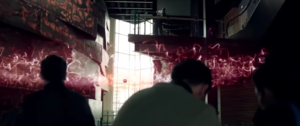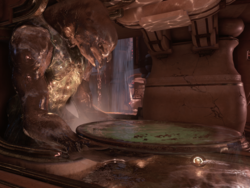Drugs: Difference between revisions
From Halopedia, the Halo wiki
No edit summary |
|||
| Line 14: | Line 14: | ||
==Humans== | ==Humans== | ||
===Ancient Humanity=== | ===Ancient Humanity=== | ||
Humanity has a long history of using medication for all manner of purposes. Nothing is known about the use of drugs in the species' first interstellar civilization, but more knowledge exists concerning human drug use in the time after Forerunners reduced them following the series of wars between the two empires. | Humanity has a long history of using medication for all manner of purposes. Nothing is known about the use of drugs in the species' first interstellar civilization, but more knowledge exists concerning human drug use in the time after Forerunners reduced them following the series of wars between the two empires. In the area around [[Marontik]], certain leaves were known to produce an intoxicating effect when burned and inhaled. Smoke from these leaves was used to fumigate the "sacred caves" which young males would journey through as a rite of passage.<ref>'''Halo: Primordium''', ''pages 53, 275''</ref> Other plants were used for healing as well. Those who had knowledge of such medicine were vital parts of communities and were counted on to share what they knew.<ref name="rebirth">'''Halo: Rebirth'''</ref> | ||
===Acute Trauma=== | |||
26th-century humanity has developed a myriad of different treatment options for acute injuries, whether suffered in battle or purely through unlucky happenstance. One of the most widespread necessities for medics is [[biofoam]], | |||
{{Expand-section}} | {{Expand-section}} | ||
Revision as of 13:05, October 9, 2016
In the broadest sense, drugs are substances other than foods that are consumed in some fashion for the purpose of causing physiological changes in the body. Pharmaceutical drugs or medicines are those substances that are intended to diagnose, treat, cure, or prevent disease. Various intelligent species and civilizations of the Milky Way galaxy have developed and used drugs for millennia.
Covenant Empire and its remnants

As a hegemony of multiple client species, not all drugs found in the Covenant can necessarily be traced to only a single one. These formulations were used widely amongst the citizens of the empire, and some continue to evade firm classification in the post-war era. One of the most easily recognizable examples of a shared drug formulation was the sealant mesh, a thin sheet of bronze-colored material that, when properly affixed, formed a partial seal over wounds.[1] The most important part of this mesh was a coagulant that would attenuate clotting of the blood. Sealant meshes were staples found in every portable aid station, but were considered a short-term option at best.[1]
Poisonous substances and bioweapons also existed in the Covenant, and continue to do so among what remains of it. In one notable example of a mass poisoning, in 2462 Kig-Yar on adulterated Unggoy infusions in the lower districts of High Charity and on ships that they controlled. Affected Unggoy males were sterilized as a result which led to an all-out rebellion against the Covenant.[2] In 2556, a Sangheili terrorist, with the aid of a Yonhet, unleashed a toxic element in Sedra City in a mass dispersal form. This caused the catastrophic breakdown of DNA in certain humans but did not affect other species in the city. The source of this element was a a piece of Installation 04; it had been created when the Template:UNSCship's engines went supernova on the surface of the ring. In 2558, a former Covenant research laboratory on Ven III became a point of conflict between the UNSC and a nest of Kig-Yar pirates on the planet. It is possible that a bioweapon used by the UNSC against Kig-Yar there was sourced from the lab present.
Forerunners
- Ancilla: "Apply the electrolytes."
- Bornstellar Makes Eternal Lasting: "To his mouth?"
- Ancilla: "Push through the lips. Dehydration will be reversed. Rigor will be suspended."
- — An ancilla attached to the Didact's cryptum instructs Bornstellar on how to revive its former occupant.
In Forerunner society, it was the Lifeworker rate that specialized in medicine's research, production, and use.[3] Lifeworkers also employed specific Huragok designed specifically for medical purposes.[4] These Huragok were able to treat injured or diseased Forerunners and other species partly through the administration of chemical compounds they produced endogenously. Technological advancement allowed Lifeworkers to efficiently produce drugs through the use of synthesizers. This technology was later adapted for use by the Covenant in the form of its own herbal synthesizers, a technology which principally benefited ascetic San'Shyuum clerics, and which they also closely guarded.[5] Though this marvel of theirs would not be discovered and appropriated by the San'Shyuum for many years to come, some Forerunners were happy to indulge in a San'Shyuum creation when they two species were contemporaries: kasna. This alcoholic beverage was a greenish color and had a pungent, sweet and sour odor.[6] Originating purely out of Forerunner ingenuity, on the other hand, was the chemical known as inchukoa. Inchukoa was used to purge an individual of most of their fluids before that individual entered a state of xankara inside a cryptum.[7] The inchukoa would be ingested and diaphoresis would commence quickly. The Forerunner affected would become noticably dessicated and soon lapse into an unconscious state before being placed in the cryptum by others.[7] When the time finally came for the Forerunner to awaken, pharmaceutical drugs played a key role as well. An initial dose of essential nutrients, electrolytes, and other substances would be administered before simply placing them in a restorative bath rich with more chemicals. This process usually required several days, as the drugs worked to restore the body's muscle mass. These life-giving chemicals, appearing as three distinct colors (red, blue, and silver) also were commonly provided by Forerunners' personal armor, allowing them to live for years without any other sustenance.
Humans
Ancient Humanity
Humanity has a long history of using medication for all manner of purposes. Nothing is known about the use of drugs in the species' first interstellar civilization, but more knowledge exists concerning human drug use in the time after Forerunners reduced them following the series of wars between the two empires. In the area around Marontik, certain leaves were known to produce an intoxicating effect when burned and inhaled. Smoke from these leaves was used to fumigate the "sacred caves" which young males would journey through as a rite of passage.[8] Other plants were used for healing as well. Those who had knowledge of such medicine were vital parts of communities and were counted on to share what they knew.[9]
Acute Trauma
26th-century humanity has developed a myriad of different treatment options for acute injuries, whether suffered in battle or purely through unlucky happenstance. One of the most widespread necessities for medics is biofoam,
 This section needs expansion. You can help Halopedia by expanding it.
This section needs expansion. You can help Halopedia by expanding it.
Jiralhanae
- "We do have the Jiralhanae, ah, beverage on hand?"
- — The Prophet of Truth makes sure one of Tartarus' favorite drinks is in good supply.
Jiralhanae enjoy a certain beverage that is rumored to be toxic if consumed by other species. It is thick, red, and noxious. In the Covenant's final years, reserves of this drink were kept for only the most high-ranking Jiralhanae, by order of the Prophet of Truth.[10][note 1]
Sangheili

Doctors are rare among Sangheili due to the widespread aversion to surgery in the species' cultures.[11] However, the stigma against the cutting of flesh outside of battle has not kept them from using medicinal substances. Sangheili have drugs that not only for healing, but also for memory improvement and for dealing with anxiety.[12] It is common to find all of these varieties of medications in temples built for kaidons, which traditionally have been visited by them prior to planning a military campaign. In such hallowed places, all manner of compounds are dispersed throughout flowing water, which has led to the label, "healing water".[12] Included among these are nootropics, which naturally would be very useful for kaidons making plans for war. Anti-anxiety medications in the water, interestingly, take the form of micro-biotic organisms that evidently can produce this effect in Sangheili. The species also has a penchant for alcoholic beverages, including those produced by humans;[13] but draughts can be found on Sanghelios as well. In the previously-mentioned temples, these may be laced with specific herbs.[12] In addition to substances for healing, Sangheili also employ those that are designed to harm. The radioactive ammunition fired by Type-51 and Type-57 carbines is in large part actually a compound mined from a moon and several other locations in the Urs–Fied–Joori system. This toxic substance is released into a victim's bloodstream after the round it was previously encased in shatters. If the one being shot doesn't die immediately, chances are high that they will succumb soon thanks to the toxin. If they hope to live, medical care must be applied right away and they should be monitored for some time afterward.[14]
San'Shyuum
- "The San'Shyuum have always excelled in the arts of intoxication."
- — a compliment from the Confirmer.
Medicinal comforts are mainstays of San'Shyuum culture. The drugs that are known to be consumed by the species are almost all those which provide pleasure and are used recreationally. Remedial substances do exist, of course, and some of those things used for pleasure also have healing properties. In the time prior to the firing of the Halo Array, the alcoholic kasna made on Janjur Qom was even held in high regard by certain Forerunners.[15] Thousands of years later, it is tea, not alcohol, that was prevalent among the San'Shyuum of the Covenant. These teas could be flavored with herbs such as sky spice and sea flower. One herbal tea in particular was used as a quick-acting analgesic for those with headaches, commonly brought on by the smoking of hookah tobacco.[16] Hookah tobacco used by the Covenant's San'shyuum was smoked with the aid of a water pipe. Being a stimulant, individuals used it to grant themselves extra focus and mental acuity for a short duration. The aforementioned herbal tea that could be used to alleviate hookah-induced headaches, was produced with the aid of an herbal synthesizer, a device which could formulate any number of prescriptions. These synthesizers relied on Forerunner technology and were almost exclusively set aside for the use of privileged San'shyuum ascetic clerics.[5] In the tower districts of High Charity, a large room known as the Chancel of Recovery was filled with the gas of vaporized herbal ointments that were beneficial for the skin and lung tissue of San'shyuum.[17] These vapors had no narcotic properties; the chancel was a place of healing and meditation. Th herbs cultivated for the Chancel of Recovery were not meant for Sangheili biology, and it was taboo amongst San'Shyuum and Sangheili alike for a Sangheili to enter. Herbal steaming stations, similarly, existed apart from this large space.[18]
The San'Shyuum of millennia past, like humans, were often owners of pheru. This meant that when a fine, desiccated powder consisting of inert, short-chain organic molecules was discovered aboard derelict ships of unknown origin and determined to have psychotropic properties when given to animals such as pheru, San'Shyuum gladly administered it to their pets.[19] The effects made the pheru more docile, but the powder altered the genetic code of the creatures over time so that malformations appeared. Pheru began to eat one another and abortions were the norm among those that became pregnant. This led to widespread euthanasia administered by San'Shyuum caretakers.[19]
Unggoy
- "It's the gas, haha! When I'm on the gas, I don't know what I'm doing half the time!"
- — An intoxicated Unggoy elatedly recognizes the source of his euphoria.
Unggoy are best known for being particularly fond of recreational drug use in general. Their portable methane tanks are often also filled with what they refer to as infusions, which are narcotics.[20][21] These infusions can be consumed this way through the same breathing apparatus that they use to supply methane in inhospitable atmospheres. Unggoy have been known to make remarks about "the gas" as a psychoactive substance, which likely refers to the same mind-altering infusions which can be inhaled when in that dosage form.[22] More often, however, Unggoy will simply imbibe the compounds through a tube, similarly to the nutritious paste that they receive through food nipples.[23] The organic chemical compound, benzene, is also treated as a recreational drug by Unggoy. It is possible that the aforementioned infusions and gas may sometimes include benzene, if not always and exclusively. Benzene mostly exists as a liquid, but it evidently is typically used by Unggoy when in a gaseous form, as it has been called "lovely lung gold". Benzene is highly toxic to humans; inhalation of trace amounts or drinking it can cause cancer. For Unggoy, however, it seems at least relatively tolerable. It has even been labeled "a sacred aromatic", by Unggoy in the Covenant, which points to it having religious connotations.[24]
While knowledge of drugs used by Unggoy predominantly concerns those used for euphoria and disinhibition, Unggoy are known to be reliant on many other medications for all aspects of their health as well. In the years following the wake of the Great Schism and the dissolution of the Covenant, poor living conditions on Balaho only got worse, since the major chain of supply evaporated almost overnight. This environment made the planet eager and willing to pledge loyalty to the Created when Cortana broadcast promises of health, prosperity, and repletion. Soon after, ships appeared in the skies, bringing not only food, but medicine and other much-needed things as well.[25]
List of appearances
 This section needs expansion. You can help Halopedia by expanding it.
This section needs expansion. You can help Halopedia by expanding it.
Note
- ^ The Prophet of Truth's apparent hesitation to refer to this drink as a beverage, as well as its color, may indicate that at least part of it was comprised of human or even Jiralhanae or San'Shyuum blood. It is included here because of the rumors about its toxicity to other species.
Sources
- ^ a b Halo: Contact Harvest, page 258
- ^ Halo Encyclopedia, pages 115 and 142
- ^ Halo Waypoint: Halo: Cryptum Glossary
- ^ Halo: Last Light, Chapter 10, page 122 (Google Play edition)
- ^ a b Halo: Contact Harvest, page 143-144
- ^ Halo: Cryptum, page 181
- ^ a b Halo: Silentium, pages 50-55
- ^ Halo: Primordium, pages 53, 275
- ^ Halo: Rebirth
- ^ Halo: Broken Circle, page 197
- ^ Halo: The Cole Protocol, page 143
- ^ a b c Halo Waypoint - Anvil's Legacy Preview
- ^ Halo: Escalation, Issue #5
- ^ Halo: The Essential Visual Guide, page 38
- ^ Halo: Cryptum, page 182
- ^ Halo: Contact Harvest, page 143
- ^ Halo: Broken Circle, page 211
- ^ Halo: Broken Circle, Kindle edition, page 143
- ^ a b Halo: Cryptum, pages 268-270
- ^ Halo: The Thursday War, pages 186-187
- ^ Halo: Contact Harvest, pages 150-151
- ^ Halo 3, campaign level Halo
- ^ Halo: Mortal Dictata, page 222
- ^ Halo: Ghosts of Onyx, page 237
- ^ Halo Waypoint: Canon Fodder - Driving Force
